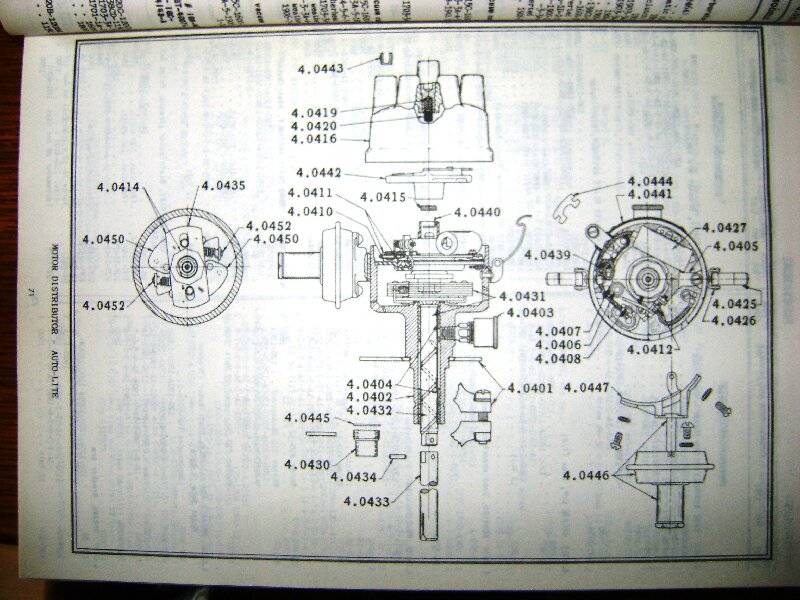|
Re: 1951 200 question
|
||||
|---|---|---|---|---|
|
Home away from home
|
I would check the distributor to see that the mechanical and vacuum advances are working.
Posted on: 2023/10/14 12:48
|
|||
|
We move toward
And make happen What occupies our mind... (W. Scherer) |
||||
|
||||
|
Re: 1951 200 question
|
||||
|---|---|---|---|---|
|
Just popping in
|
The vacuum advance is working. Can you please explain what you mean by "mechanical advance"? Thanks.
Posted on: 2023/10/14 13:53
|
|||
|
||||
|
Re: 1951 200 question
|
||||
|---|---|---|---|---|
|
Home away from home
|
Underneath the contact plate where the points and condenser are attached is a set of counterweights that fly out through centrifugal force when the distributor main shaft spins. These are shaped in such a way as to act as a cam and turn the distributor contact plate and advance the timing after start up/acceleration. There are 2 springs, one on each plate, that draw it back in as the shaft slows/stops. This allows the starter to spin the car over easier as the ignition system is slightly retarded at initial firing, yet advance to allow a smooth idle and acceleration. Further advance under load is accomplished by the vacuum advance and is evidenced by the exterior rotation of the cap. The mechanical advance is internal so cannot be seen as it only moves the contact plate.
By removing the contact plate you can check that the plates are not seized in place, or that the springs are loose/missing. The image below shows them at the far left of the page. Bob J.
Posted on: 2023/10/14 14:51
|
|||
|
||||
|
Re: 1951 200 question
|
||||
|---|---|---|---|---|
|
Home away from home
|
Bob J offers a comprehensive explanation of the distributor advance functions. A quick and easy way to check is to remove the cap and see if you can wiggle the rotor back and forth. If the rotor wiggles, then the mechanical advance is probably working.
I once had a car where the mechanical advance mechanism became rusted and would not function. After cleaning and servicing the mechanism work and made a completely different performing engine.
Posted on: 2023/10/15 13:37
|
|||
|
We move toward
And make happen What occupies our mind... (W. Scherer) |
||||
|
||||
|
Re: 1951 200 question
|
||||
|---|---|---|---|---|
|
Just popping in
|
Thank you for the info and the excellent diagram. I did not even know that it had a mechanical advance. I will check on it this weekend and try to determine whether or not it is functioning. Thanks again.
Posted on: 2023/10/16 18:08
|
|||
|
||||
|
Re: 1951 200 question
|
||||
|---|---|---|---|---|
|
Home away from home
|
Couple simple checks;
Fuel pressure - should be below 6 psi. If fuel rich suspect, tail pipe will get coated in black soot. Bogging down is usually a lack of fuel. When the throttle opens or the accelerator pump actuates, insufficient fuel flow for the air intake - becomes not flammable and dies. Check the fuel/fuel tank & line, it's been sitting 5 years and may need cleaned/dried out and fresh gas. The old accelerator pumps had leather cup seals and can dry and harden, same with paper gaskets that been soaked in gas/ethanol, so may need a partial carb refurb. Put a timing light on it, if mark's not moving on accel then the timing advance is not. The other is a bad vacuum leak, but they usually indicate with a rough idle. "Vacuum idlers" are affected. Weak spark but less likely. More fuel needs strong spark to ignite. Obstructions. Sitting and subject to all sorts of things happening. Check air cleaner, intake/exhaust, etc. Mice will nest in eh damnedest places. Once my motor home wouldn't start after winter storage. I was traveling so had it towed to mechanic because I had a trip planned for weekend. I'd had fuel tank issues, so that was suspect. Air cleaner was full of mice nest.
Posted on: 2023/10/17 8:41
|
|||
|
||||
|
Re: 1951 200 question
|
||||
|---|---|---|---|---|
|
Home away from home
|
Greg, all the others above give you the most apt advice. I would only caution that you never use starting fluid. Sure, it works, but you can so damage your engine. F a r safer is to use a bit of carburetor cleaner instead of ether.
Had a little old lady's 48,414-mile not Pasadena but nearby Hawthorne '51 200 long ago in my 20s so i could spare my rebuilt '40 One-Twenty for special occasion by driving something my age labeled Packard. Tho' not a postwar Packard fan, no '50s domestic automobile had better ergonomics. Had it stick/OD instead of Ultramatic, albeit the latter perfectly rebuilt with the smaller 9-inch direct drive clutch by a former Packard service wrench/transmission specialist, i'da kept it longer. Mechanix Illustrated's Tom McCahill preferred the Ultramatic '51 "baby" 200 as he and they called it over the 400 Patrician.
Posted on: 2023/10/17 14:18
|
|||
|
||||

 Auto-Lite Distributor.JPG (238.63 KB)
Auto-Lite Distributor.JPG (238.63 KB)







